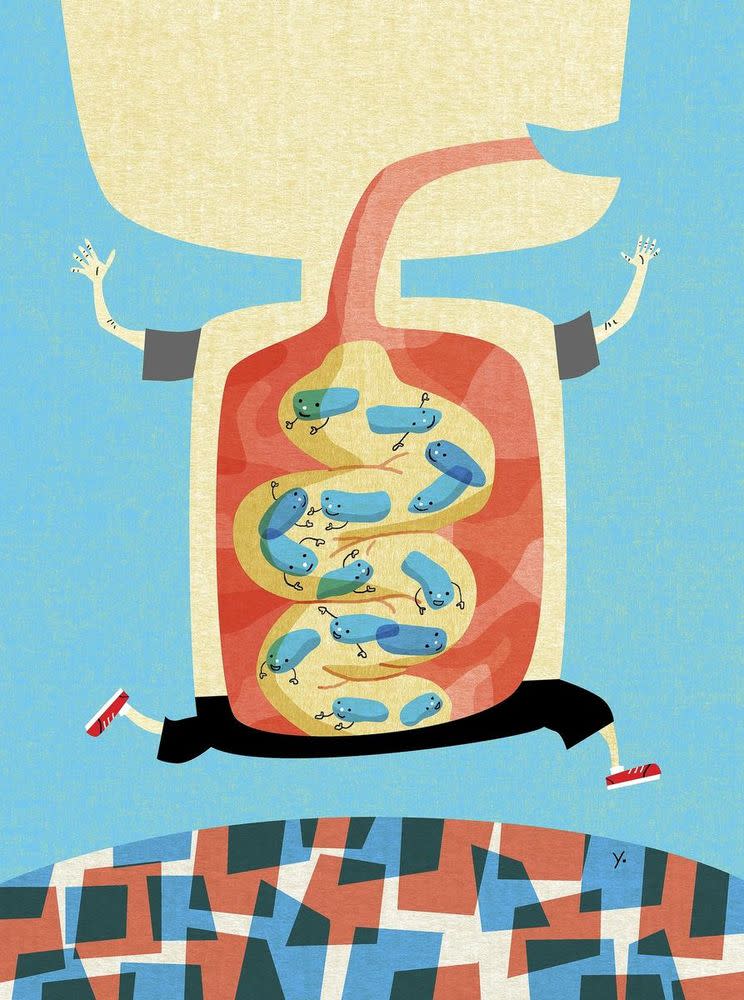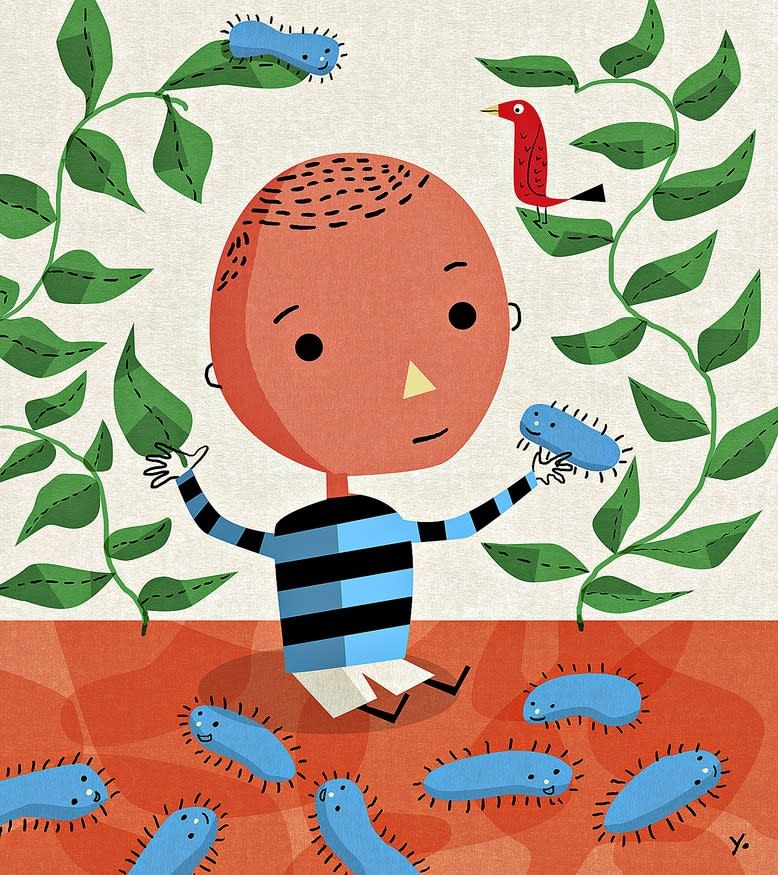5 Ways to Boost Your Kid's Gut Health

I spend my weekdays studying the human microbiome (a fancy word for the trillions of bacteria that inhabit the human gastrointestinal tract) and examining how dietary choices, antibiotic use, and other factors affect it. Weighing in at a whopping 3 to 5 pounds per person, these bacteria help control the immune system, determining things such as whether your child has an allergic reaction to a peanut and how effectively she fights off a cold virus. In addition, the microbiome is involved in regulating metabolism and weight gain, and may be wired to the brain—meaning that it could influence mood and potentially protect your child from mental-health disorders such as autism or depression. Needless to say, these findings have impacted the way my husband (who, like me, works as a microbiologist at Stanford University) and I are raising our daughters, Claire, 10, and Camille, 7. We’ve also written about it in our book,
The Good Gut: Taking Control of Your Weight, Your Mood, and Your Long-Term Health.
Unlike the human genome, which is fixed at conception, the human microbiome is largely a product of lifestyle and environment—and it’s most malleable in infancy and childhood. By the time kids reach school age, the general makeup of their microbiome has been established and will remain with them for years, decades, or even their entire life. Fortunately, nurturing your kid’s microbiome doesn’t have to be hard. These are the simple guidelines that we follow in our family.
1. Feed the Good Bacteria
They thrive on dietary fiber, the complex carbohydrates found in plants. What happens if your child’s gut bacteria don’t get enough dietary fiber? They will start eating her! Research suggests that a starving gut microbe eats the mucus that lines and protects the inner walls of the intestine. If bacteria get too close to these walls, they can set off alarm bells within the immune system, resulting in a simmering state of inflammation that can eventually lead to autoimmune disorders such as inflammatory bowel disease, allergies, and asthma. Feeding your child a diet rich in fruits, vegetables, whole grains, nuts, and legumes ensures that her developing microbiome has lots of nourishment.
Of course, many high-fiber foods don’t have instant kid appeal, to say the least. So start with familiar choices: carrots dipped in hummus, steamed edamame, or black-bean quesadillas with avocado on whole-grain tortillas. If you think your child will appreciate it, you could also put her imagination to work. We have taught Claire and Camille that we all have a “pet” named bacteria living inside of us that needs care. When faced with a plate full of vegetables (as is the norm at our house), we remind our girls that their pet is hungry, and they are usually happy to oblige. To really bring home the message, we used to give each daughter a stuffed bacterium to hold on her lap during mealtimes. I love the website GiantMicrobes.com, which carries adorable plush ones.
2. Eat Bacteria Itself
Consuming live and active cultures (another word for good bacteria), such as those found in many yogurts, may reduce the frequency of illness in children, particularly pesky gastrointestinal infections, according to research from Georgetown University Medical Center.
The fermented dairy drink kefir is another form of edible bacteria (so are miso and unpasteurized sauerkraut—but I find they’re less kid-friendly). But shop carefully: Many yogurts marketed to children are packed with sugar, and foods like yogurt-covered pretzels and yogurt-based salad dressings often don’t contain live cultures at all. To get my children to appreciate the unique tang of unsweetened yogurt, I added a teaspoon of maple syrup and then slowly reduced the amount over a number of weeks. I’ll never forget the day we wound up staying at a hotel that served sweetened yogurt. My children complained that “something tasted weird” about it—proof that you can change which flavors young kids find “normal.”

As parents, we naturally want to protect our children from illness-causing bacteria like strep and E. coli, but by sterilizing everything our kids touch we also reduce their contact with the good bacteria needed in their gut. A group of Swedish scientists recently found that children whose parents sucked their pacifiers to clean them (as opposed to boiling them on the stove) were less likely to develop eczema and asthma. It’s likely that by not sterilizing the pacifiers, these parents increased their child’s exposure to bacteria, which in turn helped to bolster their child’s developing immune system. Dentists may point out that this practice could raise the chance of tooth decay, but I still contend that we need to curb how often we sterilize our kids’ environment. If you’re not comfortable with the pacifier trick, try exercising some restraint with hand sanitizer or switching from bleach-based cleaning products to natural ones. In our family we are constantly performing a cost-benefit analysis when it comes to bacteria. If my children have been gardening in our pesticide-and herbicide-free yard, I feel comfortable having them skip hand-washing before eating a snack. But if we’ve spent the day at the zoo or a public park—a place that is potentially rife with contagious viruses as well as bacteria—handwashing before mealtime is a must.
4. Avoid Unnecessary Antibiotics
These drugs can be lifesaving, but that doesn’t mean they don’t have drawbacks. Because they kill bacteria indiscriminately, they get rid of the good parts of your microbiome along with the bad. And that loss can have a broader impact on your child’s long-term health than you might realize. A 2014 University of Chicago study on mice has linked antibiotics with peanut allergies, and a recent Johns Hopkins University study connected antibiotic use in children with excess weight gain throughout childhood. As I see it, this effect likely resulted from antibiotics’ progressive alteration of the functionality of the microbiome. In light of this new research, it is more important than ever that parents and pediatricians reserve antibiotics only for illnesses for which they are necessary. So far this strategy has paid off with my kids: Claire has never been prescribed oral antibiotics, and Camille has only taken them once in her life—for an ear infection.
5. Play in the Garden and Snuggle with Your Pets
Both activities are easy ways for your child to encounter good bacteria while avoiding the ones that can make him sick. Our dog actually serves as an ideal conduit between the bacteria-laden dirt in our yard and our children. Instead of cringing when I see him nuzzling my daughters and licking their faces, I think about the benefits that the bacteria he’s carrying can bestow on them. For example, a recent study published in JAMA Pediatrics suggested that babies who grow up exposed to dogs are less likely to develop asthma before they reach age 6. As for gardening, it exposes children to bacteria from soil and animals. My kids routinely dig carrots out of our garden with their bare hands and quickly brush the dirt off before snacking on them. In fact, I view each unwashed carrot my girls eat as the ultimate vitamin: a fiber-filled supplement that nourishes the gut microbiome. And though I don’t have any lab results to prove that my kids’ guts are benefiting, they rarely get sick, and when they do, their illnesses never last long.

